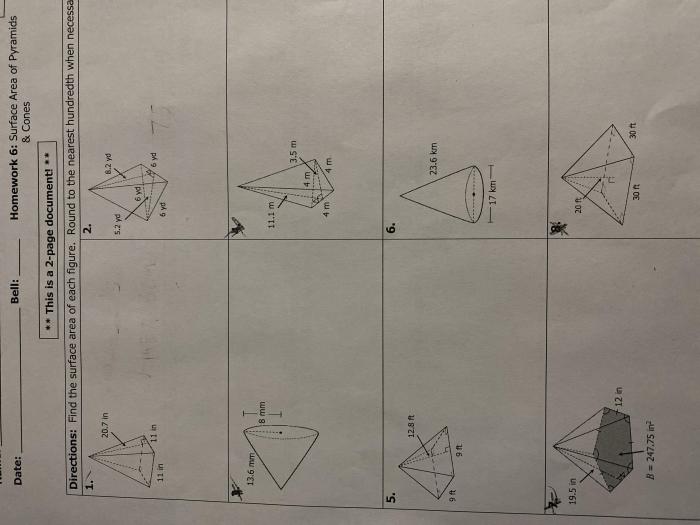Embarking on a journey of geometrical exploration, we present the surface area homework 3 answer key, a comprehensive guide to unraveling the complexities of surface area calculations. This key provides invaluable insights into the concepts, applications, and measurement techniques of surface area, empowering students to conquer geometrical challenges with confidence.
Delving into the realm of surface area, we uncover its significance in real-world applications, from architectural masterpieces to engineering marvels. We explore the intricate relationship between surface area and volume, revealing how it governs diverse processes in nature and technology.
Surface Area Calculations

Surface area refers to the total area of a three-dimensional object’s exterior surface. It is an important concept in various scientific and engineering disciplines, as it influences numerous physical phenomena.
Formulas for calculating surface area vary depending on the shape of the object. For instance, the surface area of a rectangular prism is given by 2(wl + wh + hl), where w is the width, l is the length, and h is the height.
Similarly, the surface area of a sphere is calculated as 4πr², where r is the radius.
Surface area is commonly measured in square units, such as square meters or square feet.
Applications of Surface Area
Surface area finds applications in diverse fields, including architecture, engineering, and biology.
- In architecture, surface area is crucial for determining the amount of paint or cladding needed for a building’s exterior.
- In engineering, surface area plays a role in heat transfer calculations, fluid flow analysis, and the design of heat exchangers.
- In biology, surface area is a key factor in diffusion, respiration, and the absorption of nutrients.
Surface Area and Volume: Surface Area Homework 3 Answer Key

Surface area and volume are closely related concepts. The surface area-to-volume ratio is a dimensionless quantity that indicates the relative size of an object’s surface area compared to its volume.
A high surface area-to-volume ratio facilitates processes such as diffusion and cooling. This is why organisms with high metabolic rates, such as small mammals, tend to have a large surface area-to-volume ratio.
Surface Area Measurement Techniques
Various methods exist for measuring surface area, each with its advantages and limitations.
- Direct Measurement:Using a measuring tape or calipers to directly measure the surface area of an object.
- Geometric Approximation:Approximating the surface area of an object using geometric formulas based on its shape.
- BET Method (Brunauer-Emmett-Teller):A technique used to measure the surface area of highly porous materials by adsorbing a known amount of gas onto the surface.
General Inquiries
What is surface area?
Surface area is the total area of the exposed surfaces of a three-dimensional object.
How do I calculate the surface area of a rectangular prism?
To calculate the surface area of a rectangular prism, multiply the length, width, and height of the prism and add the areas of the two bases.
What is the relationship between surface area and volume?
Surface area and volume are related by the surface area-to-volume ratio, which affects processes such as heat transfer and diffusion.
